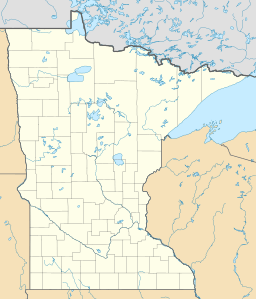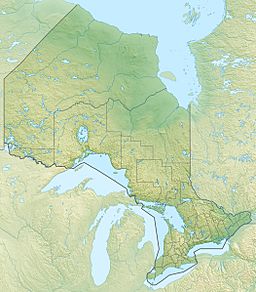Saganaga Lake facts for kids
Quick facts for kids Saganaga Lake |
|
|---|---|

Canoeists near Cache Bay
|
|
| Location | Ontario / Minnesota |
| Coordinates | 48°14′39″N 90°54′43″W / 48.24417°N 90.91194°W |
| Type | glacial lake |
| Primary inflows | Saganaga Falls on the Granite River; Seagull River; Curran Bay from Northern Light Lake |
| Primary outflows | Silver Falls in Cache Bay |
| Basin countries | Canada, United States |
| Surface area | 13,832 acres (5,598 ha) |
| Max. depth | 280 ft (85 m) |
| Surface elevation | 1,430 ft (440 m) |
| Frozen | typically November to May |
| Islands | Campers Island, Connors Island, Horseshoe Island, Munker Island, many others |
Saganaga Lake is a very large lake located right on the border between Minnesota in the United States and Ontario in Canada. It is a special place because it is protected by important wilderness areas. In the U.S., it's part of the Boundary Waters Canoe Area Wilderness. In Canada, it's protected by Quetico Provincial Park and La Verendrye Provincial Park.
This lake is super deep and big! It's the deepest and largest lake in the Boundary Waters Canoe Area Wilderness. It goes down about 280 ft (85 m) at its deepest point. That's like stacking 28 average-sized cars on top of each other! The lake also covers a huge area, about 13,832 acres (5,598 ha).
Saganaga Lake is a popular spot for fishing. People come here to catch fish like northern pike, walleye, lake trout, smallmouth bass, and lake whitefish. It's important to know that sometimes there are warnings about eating certain fish from the lake because of natural substances like mercury. The lake is also near the historic Hunter Island area and is next to Seagull Lake, where the Wilderness Canoe Base is located.
Exploring Saganaga Lake
Saganaga Lake is a fantastic place for outdoor adventures. Because it's part of protected wilderness areas, you can enjoy nature in a very wild and untouched way. Many people visit the lake for canoeing, kayaking, and camping.
What Makes it Special?
The lake's unique location on the international border means it's a shared natural treasure between two countries. Its deep, clear waters are home to many types of fish, making it a favorite for anglers. The surrounding forests and islands provide a habitat for various wildlife, including moose, bears, and many kinds of birds.
Outdoor Activities
- Canoeing and Kayaking: The calm waters and many islands make Saganaga Lake perfect for paddling. You can explore different bays and even find quiet spots to camp.
- Fishing: As mentioned, fishing is a big draw. Whether you're an experienced angler or just starting, there are plenty of fish to try and catch.
- Camping: There are many campsites around the lake, often accessible only by water. This gives visitors a true wilderness camping experience.
- Wildlife Watching: Keep an eye out for animals like deer, otters, and eagles. The wilderness is their home, and you might get to see them in their natural environment.
Protecting the Lake
Because Saganaga Lake is so special, it's important to protect it. The wilderness areas around it help keep the environment healthy. When people visit, they are encouraged to follow "Leave No Trace" principles. This means packing out everything you pack in, staying on marked trails, and respecting wildlife. These rules help make sure the lake stays beautiful for everyone, including future generations.





